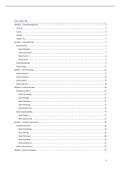Samenvatting
Summary Lectures Brand Management 2021
- Instelling
- Tilburg University (UVT)
A clear, structured summary of the lectures (PowerPoint + notes) of Brand Management, as part of the MScs Marketing Management/Analytics at Tilburg University. Henk Roest's PowerPoints are somewhat messy and chaotic, but this summary will provide you with the necessary information to ace the exam. ...
[Meer zien]




